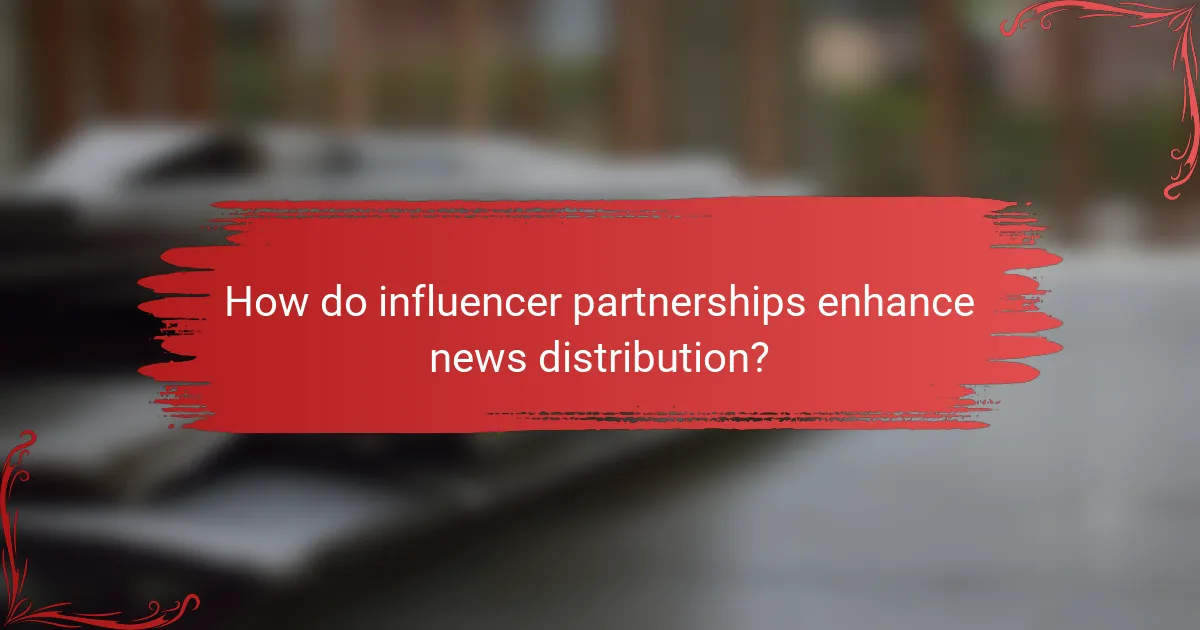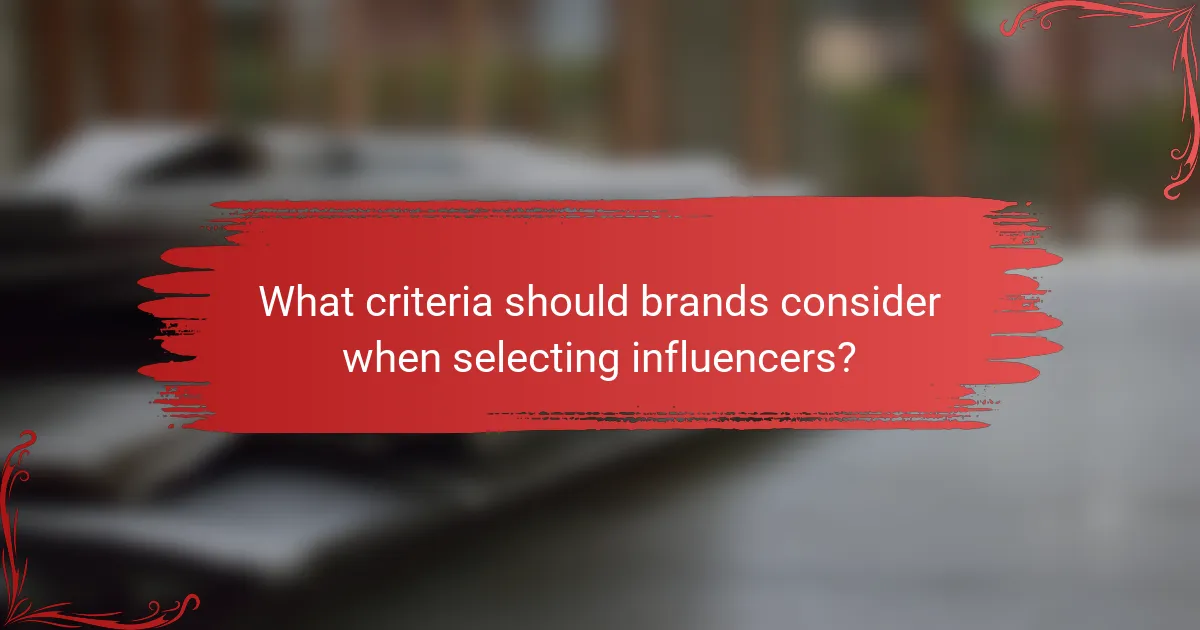Influencer partnerships play a crucial role in modern media by enhancing news distribution, audience growth, and brand credibility. By leveraging the established trust and reach of influencers, news organizations can effectively share content with new audiences, while brands can engage potential customers in a more authentic manner. This collaboration not only boosts visibility but also fosters consumer confidence, making brands appear more reliable and trustworthy.

How do influencer partnerships enhance news distribution?
Influencer partnerships significantly enhance news distribution by leveraging the reach and credibility of influencers to share content with their followers. This collaboration allows news organizations to tap into new audiences, increasing visibility and engagement with their stories.
Increased reach through social media
Influencers possess large, dedicated followings on platforms like Instagram, Twitter, and TikTok, which can amplify news content far beyond traditional media channels. By sharing articles or news segments, influencers can introduce stories to diverse demographics, expanding the potential audience significantly.
For example, a lifestyle influencer sharing a news piece about environmental issues can attract followers who may not typically engage with news outlets. This cross-pollination of audiences can lead to higher viewership and engagement rates.
Targeted audience engagement
Influencers often cater to specific niches, allowing news organizations to target particular segments of the audience more effectively. By partnering with influencers whose followers align with the news topic, organizations can ensure that their content resonates with the right people.
For instance, a tech influencer discussing a new gadget launch can engage an audience that is already interested in technology, leading to more meaningful interactions and discussions around the news shared.
Real-time content sharing
Influencers can share news content in real-time, providing immediate access to breaking news and updates. This rapid dissemination helps keep audiences informed as events unfold, which is crucial in today’s fast-paced media landscape.
Utilizing stories or live streams, influencers can provide instant commentary or insights, making the news feel more relevant and engaging. This immediacy can drive higher traffic to news sites and increase social media interactions.

What are the benefits of influencer partnerships for audience growth?
Influencer partnerships can significantly enhance audience growth by leveraging the established trust and reach of influencers. These collaborations allow brands to tap into new demographics and engage potential customers more effectively.
Access to niche markets
Influencers often cater to specific audiences with distinct interests, providing brands access to niche markets that may be difficult to reach through traditional advertising. For instance, a fitness brand can partner with a health-focused influencer to connect with fitness enthusiasts directly.
By aligning with influencers who resonate with particular segments, brands can tailor their messaging and offerings to meet the unique needs of these audiences. This targeted approach can lead to higher conversion rates and customer loyalty.
Improved brand visibility
Collaborating with influencers enhances brand visibility across various platforms, as influencers share content with their followers who trust their recommendations. This organic exposure can lead to increased brand recognition and awareness.
For example, a beauty brand partnering with a popular makeup artist can showcase products in tutorials, reaching thousands of potential customers who may not have encountered the brand otherwise. Consistent influencer collaborations can keep the brand top-of-mind for consumers.
Higher engagement rates
Influencer partnerships typically yield higher engagement rates compared to traditional advertising methods. Audiences are more likely to interact with content that features influencers they admire, leading to increased likes, comments, and shares.
Brands can benefit from this engagement by creating authentic content that resonates with the influencer’s audience. For instance, running a giveaway or challenge through an influencer can encourage participation and foster a sense of community around the brand.

How do influencer partnerships build brand credibility?
Influencer partnerships enhance brand credibility by leveraging the trust and authenticity that influencers have cultivated with their audiences. When influencers endorse a brand, their followers are more likely to view the brand as reliable and trustworthy, leading to increased consumer confidence.
Authenticity through trusted voices
Influencers are often seen as relatable figures who share genuine experiences with their followers. This authenticity is crucial; when influencers promote a brand, it feels like a personal recommendation rather than a traditional advertisement. Brands should choose influencers whose values align with their own to maintain this authenticity.
For example, a fitness brand collaborating with a well-known fitness influencer can create content that resonates with health-conscious consumers. This alignment helps reinforce the brand’s credibility in the eyes of potential customers.
Social proof and endorsements
Social proof is a powerful psychological phenomenon where people look to others to determine their own actions. Influencer endorsements serve as a form of social proof, indicating that a brand is popular and respected. When followers see their favorite influencers using a product, they are more likely to consider it for themselves.
Brands can amplify this effect by showcasing user-generated content from influencers, such as testimonials or reviews. This not only builds credibility but also fosters a sense of community among consumers who share similar interests.
Long-term relationships with influencers
Building long-term relationships with influencers can significantly enhance brand credibility. Consistent partnerships allow brands to create a cohesive narrative that resonates with audiences over time. This strategy helps establish a deeper trust as followers become familiar with the brand through repeated endorsements.
Brands should focus on nurturing these relationships by engaging with influencers beyond just transactional collaborations. Providing exclusive content, early access to products, or involving influencers in brand events can strengthen these ties and enhance credibility.

What criteria should brands consider when selecting influencers?
Brands should consider several key criteria when selecting influencers, including audience alignment, engagement metrics, and content style. These factors help ensure that the partnership will resonate with the target market and enhance brand credibility.
Audience alignment and demographics
Audience alignment is crucial for effective influencer partnerships. Brands should analyze the demographics of an influencer’s followers, such as age, gender, location, and interests, to ensure they match the brand’s target audience. For instance, a beauty brand targeting young women should collaborate with influencers who have a predominantly female audience aged 18-30.
Additionally, understanding the influencer’s audience engagement can provide insights into the potential effectiveness of the partnership. Brands can use tools to assess follower authenticity and engagement levels, which can help avoid influencers with inflated follower counts or low interaction rates.
Engagement metrics and reach
Engagement metrics, such as likes, comments, shares, and overall reach, are vital indicators of an influencer’s effectiveness. Brands should look for influencers with high engagement rates, typically above 2-3%, as this suggests a loyal and active audience. Reach, or the total number of unique users who see the influencer’s content, also plays a significant role in determining potential visibility.
Using analytics tools, brands can compare different influencers based on these metrics to identify those who can deliver the best results. A good practice is to create a shortlist of influencers with both high engagement and substantial reach to maximize campaign impact.
Content style and brand fit
The content style of an influencer should align with the brand’s image and values. Brands need to evaluate whether the influencer’s tone, aesthetics, and messaging resonate with their own branding. For example, a luxury brand may prefer influencers who maintain a polished and sophisticated content style.
Moreover, assessing past collaborations can provide insights into how well the influencer integrates brand promotions into their content. Brands should look for influencers who have successfully partnered with similar brands, as this indicates a good fit and the potential for authentic promotion.

What are effective strategies for managing influencer partnerships?
Effective strategies for managing influencer partnerships include establishing clear communication, conducting regular performance evaluations, and maintaining flexible collaboration terms. These approaches help ensure that both brands and influencers align on goals and expectations, ultimately leading to successful campaigns.
Clear communication of expectations
Clear communication is vital for successful influencer partnerships. Brands should outline specific goals, deliverables, and timelines from the outset. This clarity helps influencers understand what is expected of them and reduces the likelihood of misunderstandings.
Consider creating a detailed brief that includes campaign objectives, target audience, and key messages. Regular check-ins can also reinforce these expectations and provide opportunities for feedback. This proactive approach fosters a collaborative environment.
Regular performance evaluations
Conducting regular performance evaluations allows brands to assess the effectiveness of their influencer partnerships. Metrics such as engagement rates, reach, and conversion rates should be analyzed to gauge success. Evaluations should occur at predetermined intervals, such as monthly or quarterly.
Use these evaluations to identify areas for improvement and discuss potential adjustments with influencers. This ongoing assessment not only enhances campaign performance but also strengthens the relationship between the brand and the influencer.
Flexible collaboration terms
Flexibility in collaboration terms can enhance the effectiveness of influencer partnerships. Brands should be open to adjusting deliverables or timelines based on the influencer’s feedback or changing market conditions. This adaptability can lead to more authentic content and better audience engagement.
Establishing a framework that allows for modifications while maintaining core objectives can be beneficial. For instance, if an influencer suggests a different approach that resonates better with their audience, being open to that change can yield positive results for both parties.
